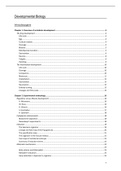Samenvatting
Samenvatting Developmental Biology (1015665BNR)
Deze samenvatting is in het Engels geschreven. Het is een samenvatting van de lessen en de website van de prof samen. Ook de tekeningen die de prof aan bord maakte staan in de samenvatting.
[Meer zien]



